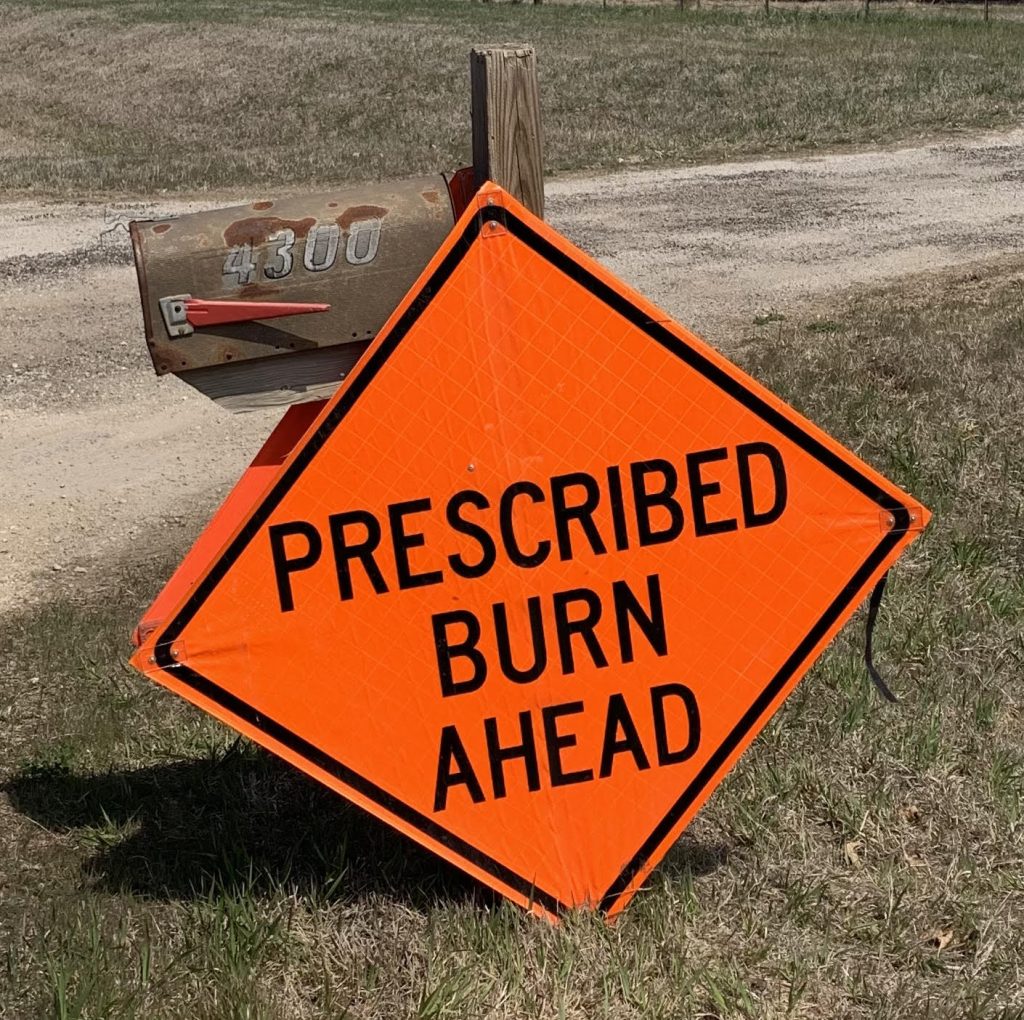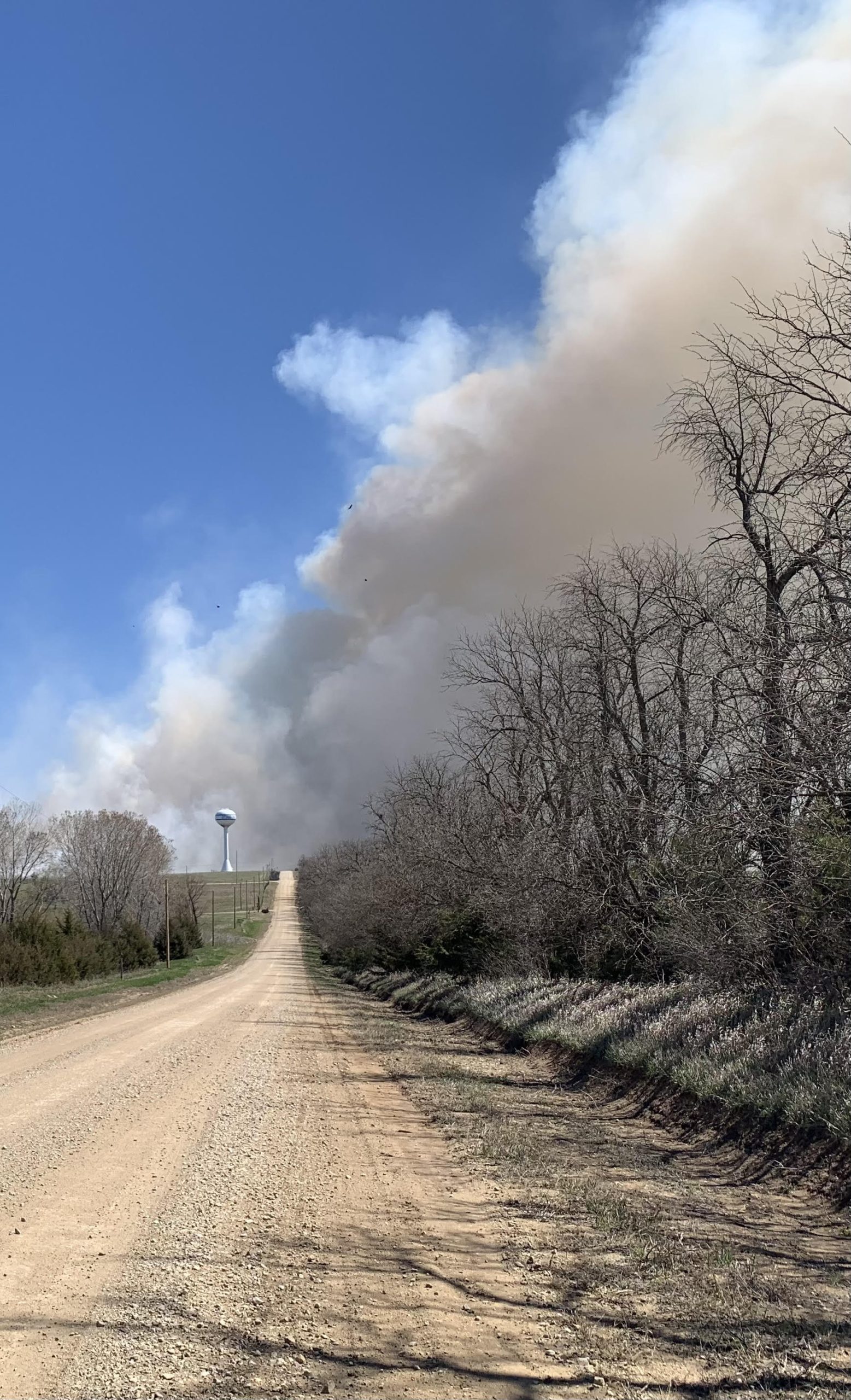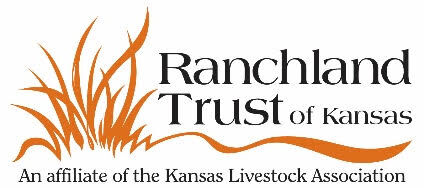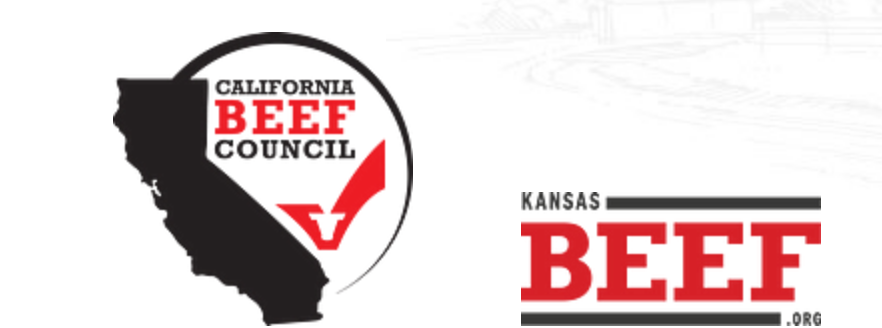Mixed into the springtime tug of war between food producers and nature are rare days when conditions are perfect to strike a match for grassland management.
Such was the case April 4 in Saline County and other areas of the Smoky Hills in central Kansas, when the weather was ripe for prescribed burns.
Farmers, ranchers, landowners and the like moved quickly to reclaim land encroached by unwanted water-wasting invasive plants, especially woody species, such as red cedar. Visibility may be reduced from smoke and flames when grass and crop stubble are being burned, such as in this April 4 fire in southeastern Ottawa County as shown in a photo taken by Tim Unruh.
“It was beautiful. Everything went in our favor,” said Adam Makovec, owner of AJM Enterprises, based in Lincolnville, Kansas. The company contracts with landowners to plan and manage prescribed burns throughout the state, up to 50 a year.
AJM burned nearly 300 acres April 4, roughly four miles northeast of Salina.
A day to burn
It was “THE day to burn,” said Paul Finnell, a farmer-rancher near Glendale, Kansas, in northwest Saline County, and president of the Smoky Hills Prescribed Burn Association, covering Saline and six surrounding counties.
He estimated the April 4 activities resulted in roughly 16,000 acres of grassland being burned in the Smoky Hills region.

South of Salina, near the McPherson County line, Landon Shaw was completing a pasture burn when he called neighbor Tom Holmquist, of Smolan, with an attractive offer.
“He said, ‘I’m burning my pasture, and we can do yours if you come right now,’ so that’s what we did,” Holmquist said. He serves on the SHPBA board of directors.
Plenty of help
With a volunteer crew of nine, the fire was ignited at 3 p.m. and by 1 a.m. April 5, nearly 500 acres had been cleared from the two burns combined.
“The fire didn’t get away. We got a really nice clean burn,” he said. “We killed some trees, burned up some dead ones and cleaned that pasture up. We cleared the hedge line on the north side, got it down to zero. It means there would be room for one more cow and calf in that pasture, just from those trees being gone, which economically helps everybody.”
Beneficial technique
Finnell estimated the benefits of the reclaimed land and moisture from Holmquist’s burn could be much higher.
“Honestly, he probably has enough room for (an additional) 10 cows and 10 calves this season,” Finnell said. “If we get the rain, you will have an explosion of grass production and a much higher quality of protein in the grass. Technically, you can put more cattle on the pasture for a season after a burn.”
Plumes of smoke from some 10 burns were spotted billowing straight up and floating away from towns, infrastructure and traffic, Makovec said on April 4.
“That’s the way of the game, catching the right conditions,” he said.
Sign up for HPJ Insights
Our weekly newsletter delivers the latest news straight to your inbox including breaking news, our exclusive columns and much more.
Fires on that perfect day burned grassland from 30-acre patches up to 500 acres, Finnell said.
“Mother Nature gave us a great day, and we took advantage of it. Those days are few and far between,” he said. “You’ve got to take advantage of every spring day that comes around with weather conditions like that.”
Encroachment of woody species is a major culprit. From 1990 through 2022, the Great Plains Grassland Extension Partnership (10 states) reported 988,133 acres of grassland were converted to woodland.
Reinvestment into prairie
The estimated loss was 42 billion pounds of grass during those 32 years, or 35 million round bales, which is enough forage to feed 3.4 million cows and 15 million steers.
“What you’re losing is the grass productivity of that ground because the trees are sucking up all the moisture,” Finnell said. “Once you remove those trees, you free up all the moisture to be utilized by the range grasses.”
One tree will use 20 gallons of water on a hot summer day, he said.
Bulldozing and sawing are other ways to remove trees, and there are contractors in the area willing to assist landowners, Finnell said, but burning is the most cost efficient.
Dealing with fire presents challenges, but the SHPBA has not had to call fire departments for assistance, he said.
“We’ve had fires that will move outside of the (prescribed) perimeter, but we’ve never had an escape on PBA burns,” he said. “There have been landowner burns where the fire departments were called, because the landowners didn’t have the water, the people and the equipment to control it. The SHPBA provides the equipment and the knowledge for safe prescribed burns.”
Controlled process
Pulling from Oklahoma State University research, Finnell estimated less than 4% of PBA burns ever escape and get out of control.
“There’s a difference between the landowner throwing a match out and the PBA doing a controlled burn,” he said. “After landowners participate in a PBA burn, and they see how it works, they walk away with less fire anxiety because they’ve learned so much about the nature of the burn and how the fire can be controlled.”
March through April is the prime time for burning between Salina east into the Flint Hills, Makovec said.
“That’s pretty much the heart of the controlled burning environment,” he said. “It’s a very valuable tool. Fire is the best and most cost-effective way to deal with (unwanted species).”
Finnell sends out weekly emails to SHPBA members during the spring burn season to keep them informed about upcoming burns. Members received their final emails for prescribed burns April 22. They will be notified again in July for grassland burns from August through September. If you wish to receive updates, email him at [email protected]. To reach AJM Enterprises, call (785) 512-0255 or email [email protected].
Tim Unruh can be reached at [email protected].
FACTOID:
The SHPBA, which covers Saline and six surrounding counties, works closely with county emergency management officials, fire departments and law enforcement to alert the public about SHPBA burning in the area.
Finnell stresses there is a difference between grassland burns and stubble fires, but there are rules governing both activities.
Regarding public notices, Smolan area farmer-rancher Tom Holmquist said weather reporters are starting to alert people when weather conditions warrant prescribed burning.
“(Meteorologists) have mentioned it, saying ‘Don’t get upset if you see some smoke in the air’ so the people in town will understand a little better,” he said.
Prairie fires can be distractions
By Tim Unruh
Prescribed burning or prairie and stubble fires in general are attention getters, said Trooper Ben Gardner of the Kansas Highway Patrol, and motorists should be prepared for these “common occurrences.”
“The biggest concern or challenge is when motorists don’t adjust to those visible obstructions before they get to them,” Gardner said, such as turning on headlights.
“Be prepared to adjust to unexpected difficulties to the visual barriers and obscurities,” he said. “We at times see people slowing to the point of stopping, and others cannot see someone has stopped, causing a crash. Make sure you stop well off the lanes, on the shoulder.”
The trooper added that it’s a violation of Kansas law if you stop on interstate highways to observe, photograph or video a fire.
“Only stop if it’s an emergency,” Gardner said. “Just basically taking in the show is not an emergency. Getting out of the vehicle would be another violation, and a person could be ticketed twice.”




